Russian Air Force: Difference between revisions
Molinaro787 (talk | contribs) Tags: Mobile edit Mobile web edit |
|||
| Line 231: | Line 231: | ||
|- style="background:#efefef; color:black" |
|- style="background:#efefef; color:black" |
||
|[[Mikoyan MiG-29]] |
|[[Mikoyan MiG-29]] |
||
|[[File:Mikoyan- |
|[[File:Malaysia - Air Force Mikoyan-Gurevich MiG-29N (9-12SD) edited.jpg|170px]] |
||
|{{USSR}}<br>{{RUS}} |
|{{USSR}}<br>{{RUS}} |
||
|[[Multirole fighter|Multirole Fighter]] |
|[[Multirole fighter|Multirole Fighter]] |
||
Revision as of 07:01, 23 December 2014
This article includes a list of general references, but it lacks sufficient corresponding inline citations. (July 2011) |
| Russian Air Force Военно-воздушные cилы России Voyenno-vozdushnye sily Rossii | |
|---|---|
 Russian Air Force emblem | |
| Active | 1992–present |
| Country | |
| Role | Air superiority, reconnaissance, close air support |
| Size | 160,000 personnel (2012)[1] |
| Anniversaries | 12 August |
| Engagements | First Chechen War War of Dagestan Second Chechen War Russo-Georgian war |
| Commanders | |
| Current commander | Colonel General Viktor Bondarev |
| Insignia | |
| Roundel |  |
The Russian Air Force (Russian: Военно-воздушные cилы России, romanized: Voyenno-Vozdushnye Sily Rossii) is the aerial warfare service branch of the Armed Forces of the Russian Federation. It is currently under the command of Lieutenant General Viktor Bondarev. The Russian Navy has its own air arm, the Russian Naval Aviation, which is the former Soviet Aviatsiya Voyenno Morskogo Flota ("Naval Aviation"), or AV-MF).
The Air Force was formed from parts of the former Soviet Air Forces after the dissolution of the Soviet Union in 1991–92. Boris Yeltsin's creation of the Ministry of Defence of the Russian Federation on 7 May 1992, can be taken as a convenient formation date for the new Air Force. Since that time, the Air Force has suffered severe setbacks due to lack of resources, and has constantly shrunk in size. Since Vladimir Putin became President of the Russian Federation however, much more money has been allocated to the Armed Forces as a whole.
History
Following the dissolution of the Soviet Union into its fifteen constituent republics in December 1991, the aircraft and personnel of the Soviet Air Forces – the VVS were divided among the newly independent states. General Pyotr Deynekin (ru), the former deputy commander-in-chief of the Soviet Air Forces, became the first commander of the new organisation on 24 August 1991. Russia received the majority of the most modern fighters and 65% of the manpower. The major commands of the former Soviet VVS – the Long Range Aviation, Military Transport Aviation and Frontal Aviation were renamed, with few changes, Russian VVS commands. However, many regiments, aircraft, and personnel were claimed by the republics they were based in, forming the core of the new republics' air forces. Some aircraft in Belarus and Ukraine (such as Tu-160s) were returned to Russia, sometimes in return for debt reductions, as well as a long range aviation division based at Dolon in Kazakhstan.
During the 1990s, the financial stringency felt throughout the armed forces made its mark on the Air Forces as well.[2] Pilots and other personnel could sometimes not get their wages for months, and on occasion resorted to desperate measures: four MiG-31 pilots at Yelizovo in the Far East went on hunger strike in 1996 to demand back pay which was several months overdue, and the problem was only resolved by diverting unit monies intended for other tasks.[3] As a result of the cutbacks, infrastructure became degraded as well, and in 1998, 40% of military airfields needed repair. The situation only began to improve after Putin took power and military budgets were greatly increased.
The VVS participated in the First Chechen War (1994–1996) and the Second Chechen War (1999–2002). These campaigns also presented significant difficulties for the VVS including the terrain, lack of significant fixed targets and insurgents armed with Stinger and Strela-2M surface-to-air missiles.
During the 1990s the Sukhoi design bureau designed a replacement bomber aircraft, the T-60S. This aircraft did not reach the production stage. A further abortive design project was the MiG 1.42.
The former Soviet Air Defence Forces remained independent for several years under Russian control, only merging with the Air Forces in 1998. The decree merging the two forces was issued by President Boris Yeltsin on 16 July 1997. During 1998 altogether 580 units and formations were disbanded, 134 reorganized, and over 600 given a new jurisdiction.[4] The redistribution of forces affected 95% of aircraft, 98% of helicopters, 93% of anti-aircraft missile complexes, 95% of the equipment of radiotechnical troops, 100% of anti-aircraft missiles and over 60% of aviation armament. More than 600,000 tons of material changed location and 3500 aircraft changed airfields. Military Transport Aviation planes took more than 40,000 families to new residence areas.
The short-lived operational commands were abolished. Two air armies, 37th Air Army (long-range aviation) and 61st Air Army (former Military Transport Aviation), were established directly under the Supreme Command. The former frontal aviation and anti-aircraft forces were organized as Air Force Armies and Anti-Aircraft Defense Armies under the military district commanders. There were initially four such armies with headquarters in St.Petersburg (Leningrad Military District), Rostov-on-Don (Caucasus Military District), Khabarovsk (Far East Military District), and Chita (Siberian Military District). Two military districts had separate Air and Air Defence Corps. When the Transbaikal Military District and Siberian Military District were merged, the 14th Air Army was reactivated to serve as the air force formation in the area.
The number of servicemen in the Air Force was reduced to about 185 000 from the former combined number of 318,000. 123,500 positions were abolished, including almost 1000 colonel positions. The resignation of 3000 other servicemen included 46 generals of which 15 were colonel generals. On 29 December 1998 Colonel General Anatoly Kornukov, a former Air Defence Forces officer and new commander-in-chief of the merged force, succeeding Deynekin, reported to the Russian defence minister that the task had 'in principle been achieved'.[5] General Kornukov established the new headquarters of the force in Zarya, near Balashikha, 20 km east of the centre of Moscow, in the former PVO central command post, where the CIS common air defence system is directed from.
Since 2000

General Kornukov was succeeded by General Vladimir Mikhaylov in 2002.
In December 2003 the aviation assets of the Army—mostly helicopters—were transferred to the VVS, following the shooting down of a Mi-26 helicopter in Chechnya on 19 August 2002, that claimed 19 lives. The former Army Aviation was in its previous form intended for the direct support of the Ground Forces, by providing their tactical air support, conducting tactical aerial reconnaissance, transporting airborne troops, providing fire support of their actions, electronic warfare, setting of minefield barriers and other tasks. The former Army Aviation is now managed by the Chief of the Department of Army Aviation, who in mid-2007 was Lieutenant General Anatoly Surtsukov.[6]
In October 2004 the disbandment was announced of the 200th and 444th Bomber Aviation Regiments with Tupolev Tu-22M3, of the 28th, 159th, 790th, and 941st Fighter Aviation Regiments, of the 302nd and 959th Regiments equipped with Sukhoi Su-24, and of the 187th and 461st Assault Aviation Regiments with the Sukhoi Su-25.[7] These disbandments did not go ahead.
The Air Force continues to suffer from a lack of resources for pilot training. In the 1990s Russian pilots achieved approximately 10% of the flight hours of the United States Air Force. The 2007 edition of the International Institute for Strategic Studies (IISS) Military Balance listed pilots of tactical aviation flying 20–25 hours a year, 61st Air Army pilots (former Military Transport Aviation), 60 hours a year, and Army Aviation under VVS control 55 hours a year.[8]
General Mikhailov was succeed by General Colonel Aleksandr Zelin in 2007. Zelin said in August 2007 that by 2011 the Air Force would deploy advanced unmanned aerial vehicles (UAV) with flight range of up to 400 kilometers (250 mi) and flight duration of up to 12 hours.[9] The UAVs of both fixed- and rotary-wing types will perform a variety of tasks, including reconnaissance, attack, retransmission of radio signals and target designation, he said.[9]
| Russian Armed Forces |
|---|
 |
| Staff |
| Services (vid) |
| Independent troops (rod) |
| Special operations force (sof) |
| Other troops |
| Military districts |
| History of the Russian military |
In August 2007, the commander of the 16th Air Army, General Major Alexander Belevitch, said that the 16th Air Army would soon receive two regiments of the advanced Su-34 Fullback fighter-bombers in the near future.[10] However, as of 2010, only 16 Su-34s are in service, and only one frontline unit has received any aircraft.[11] Belevitch also said the formation would receive MiG-29SM 'Fulcrum' fighters to replace outdated MiG-29s and modernised Su-25 Frogfoot close support aircraft, which showed outstanding performance during operations in Afghanistan, Chechnya and other "hot spots."[10]
Russia resumed the Soviet-era practice of sending its bomber aircraft on long-range flights at a permanent basis in July and August 2007, after a 15-year unilateral suspension due to fuel costs and other economic difficulties after the collapse of the Soviet Union.[12][13] Patrols towards the North Pole, the Atlantic and the Pacific Ocean were reinstated, bringing the planes often close to NATO territory, most recently flying over the Irish Sea, between the UK and Ireland.[14]
In 2008 the Air Force lost between 4 and 7 aircraft to Georgian anti-aircraft fire during the 2008 South Ossetian War.
Warfare.ru indicates that in early 2009 the Air Force went through a major restructuring, in which air armies were succeeded by commands, and most air regiments becoming airbases.[15] However, Combat Aircraft, in a piece by Stefan Buttner in its August–September 2009 issue, presented the order of battle as being substantially unchanged.[16] Eventually Aviation Week & Space Technology confirmed that the reorganisation would be completed by December 2009 and would see a 40 percent reduction in aircrew numbers.[17]
In February 2009, the Russian newspaper Kommersant reported that 200 of the 291 MiG-29s currently in service across all Russian air arms were unsafe and would have to be permanently grounded.[18] This action would remove from service about a third of Russia's total fighter force, some 650 aircraft.
On 5 June 2009, the Chief of the General Staff, Nikolai Makarov said of the Russian Air Force that "They can run bombing missions only in daytime with the sun shining, but they miss their targets anyway".[19] Maj. Gen. Pavel Androsov said that Russia's long-range bombers would be upgraded in 2009 with the aim of being able to hit within 20 meters of their targets.[20]
On 18 August 2009, the Russian Government signed a contract for 48 Su-35BM, 4 Su-30M2 and 12 Su-27SM's at the MAKS-2009 air show.[21]
Also in September 2009 it was reported that an East European network of the Joint CIS Air Defense System was to be set up by Russia and Belarus.[22] This network was to be established to jointly protect the Russia-Belarus Union State’s airspace. Its planned composition was to include five Air Force units, 10 anti-aircraft units, five technical service and support units and one electronic warfare unit. It was to be placed under the command of a Russian or Belarussian Air Force or Air Defence Force senior commander.
A number of Russian aviation companies have been attempting to develop advanced fighter aircraft to replace the large number of aging MiG-29 and Su-27 aircraft in service. All have been severely affected by funding difficulties. Sukhoi has emerged as the frontrunner. The Sukhoi PAK FA – Future Air Complex for Tactical Air Forces – has been under development since 2002. The first prototype made its initial flight on 29 January 2010. A 2015 date has been announced for service entry.[23]
There has recently been discussion over changing the Soviet red star insignia on aircraft. In March 2010, a new roundel was proposed in the State Duma, adding an outline of blue, to reflect all three colours of the national flag.[citation needed] While this proposal was rejected in the Federation Council,[citation needed] pictures exist showing some aircraft have had the three-colour insignia applied.[citation needed]
In July 2010, Russian jet fighters made the first nonstop flights from European Russia to the Russian Far East.[24]
By August 2010, according to the commander-in-chief of the Russian Air Force Aleksandr Zelin (interview to the Ekho Moskvy radio station, 14 August 2010), the average flight hours of a pilot in Russian tactical aviation had reached 80 hours a year, while in army aviation and military transport aviation it exceeded 100 hours a year.[25]
As of 15 August 2010, the Russian Air Force temporarily grounded its fleet of Su-25 ground attack aircraft to conduct an investigation into a crash that happened during a training mission. The Russian Defence Ministry said that the plane crashed on 6 August 2010, 60 km to the north-west of Step air base in Siberia, according to RIA Novosti. The plane is in the process of being upgraded by the Russian Air Force. The crew of the plane ejected to safety before it hit the ground and there were no civilian injuries.
In 2010, the 2003 decision to transfer the Army Aviation to the Air Force was reversed. Also, 18 new aviation brigades will be created.[26]
Since 2012
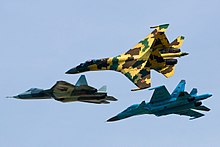
Currently the Russian Air Force operates a total of 61 air bases. This includes 26 air bases with tactical aircraft, of which 14 are equipped with fighter aircraft.
In 2012, the Air Force was made up of:
- 38 fighter squadrons (7 operating MiG-29s, one operating the MiG-29S, 2 operating the MiG-29SMT, 7 operating the MiG-31, one operating the MiG-31B, 4 operating the MiG-31BM, 7 operating the Su-27P, 8 operating the Su-27SM, 1 operating the Su-27SM3 and Su-30M2, 1 operating the Su-35S, 1 operating the Su-30SM)
- 15 bomber squadrons (9 operating the Su-24M, 2 operating the Su-24M2, 4 operating the Su-34)
- 14 assault squadrons (10 operating the Su-25, 4 operating the Su-25SM)
- 9 intelligence squadrons (operating the Su-24MR, and various UAVs)
- 13 training and testbed squadrons
In terms of flight hours, pilots in the Western Military District averaged 125 hours over the 2012 training year. Pilots from the Kursk airbase achieved an average of 150 hours, with transport aviation averaging 170 hours.[27]
Ranks and Insignia

The independent Russia inherited the ranks of the Soviet Union, although the insignia and uniform was altered a little, especially the re-introduction of the old Czarist crown and Double-headed eagle. The Russian Air Force is an independent organisation. The Russian Air Force follows the same rank structure as the Russian Ground Forces, with the addition of the title "of aviation" to each officers rank.
Organization

In 2009 the Russian Air Forces' structure was completely changed to a command-air base structure from the previous structure of air army-air division or corps-air regiment. The VVS is now divided to 4 operational commands, the Operational Strategic Command for Air-Space Defence (seemingly primarily made up of the former Special Purpose Command), the Military Transport Aviation Command, and the Long Range Aviation Command.[28] This listing is a composite; the available new information covers frontline forces, and the forces of central subordination are as of approximately August 2008. Warfare.ru maintains what appears to be a reasonably up to date listing, and Combat Aircraft magazine in June 2010 listed their organisation's estimate of the new order of battle.
- Operational Strategic Command for Air-Space Defense (Moscow)
- 4th Air-space defense brigade (Dolgoprudnyi, Moscow Oblast)
- 5th Air-space defense brigade (Petrovskoe, Moscow Oblast)
- 6th Air-space defense brigade (Rzhev, Tver Oblast) (former 32nd Corps of PVO?)
- 6963rd aviation base (Kursk Vostochny Airport) (MiG-29SMT(UBT))
- 6968th fighter aviation base (Borisovsky Khotilovo, Tver Oblast) (Su-27, MiG-31B, MiG-31BM)
- 1st Air and Air Defence Forces Command (Voronezh) (Western Military District) — (includes elements of former 6th Army of VVS and PVO)
- 1st Air-space defense brigade (Severomorsk)
- 2nd Air-space defense brigade (St. Petersburg)
- 6961st aviation base (Petrozavodsk Airport) (Su-27)
- 6964th aviation base (Monchegorsk Airbase, Murmansk Oblast) (Su-24M, Su-24MR)
- 6965th aviation base (Vyazma Airport, Smolensk Oblast) (Mi-8TM, Mi-24V, Mi-28N)
- 7000th aviation base (Voronezh Malshevo Airbase) (Su-24M, Su-24MR, Su-34)
- 2nd Air and Air Defence Forces Command (Yekaterinburg) (Central Military District)
- 8th air-space defense brigade (Yekaterinburg)
- 9th air-space defense brigade (Novosibirsk)
- 10th air-space defense brigade (Chita)
- 6977th aviation base (Bolshoye Savino Airport, Perm Krai) (MiG-31)
- 6979th aviation base (Kansk Airbase, Krasnoyarsk Krai) (MiG-31BM)
- 6980th aviation base (Chelyabinsk Shagol Airport) (Su-24M)
- 6982nd aviation base (Doman Airbase, Zabaykalsky Krai) (MiG-29, Su-30SM)
- 3rd Air and Air Defence Forces Command (Khabarovsk) (Eastern Military District)
- 11th air-space defense brigade (Komsomolsk-na-Amur)
- 12th air-space defense brigade (Vladivostok)
- 6983rd aviation base (Vozdvizhenka Airbase, Primorsky Krai) (Su-25SM, Mi-8TM, Mi-24P)
- 6987th aviation base (Komsomolsk-on-Amur Airport, Khabarovsk Krai) (Su-27SM, Su-30M2, Su-35S)
- 6988th aviation base (Khurba, Khabarovsk Krai) (Su-24M, Su-24M2, Su-24MR)
- 6989th aviation base (Vladivostok International Airport) (Su-27SM)
- 265th transport aviation base (Khabarovsk)
- 4th Air and Air Defence Forces Command — Southern Military District (former 4th and 5th Armies of VVS and PVO)(Rostov-on-Don)
- 7th air-space defense brigade (Rostov-on-Don)
- 8th air-space defense brigade (Yekaterinburg)
- 6970th aviation base (Morozovsk, Rostov Oblast) (Su-24M, Su-34)
- 6971st aviation base (Budenovsk, Stavropol Krai) (Su-25SM, Mi-8AMTSh, Mi-24V, Mi-28N)
- 6972nd aviation base (Krymsk, Krasnodar Krai) (Su-27, Mi-8, Mi-24P, Mi-28N, Ka-27)
- 6974th aviation base (Korenovsk, Krasnodar Krai) (Mi-8MTV-5, Mi-24V, Mi-35M, Mi-28N)
- 999th aviation base (Kant Air Base, Kyrgyzstan) (Su-25, Su-27, Mi-8T)
- 229th transport aviation base (Rostov-on-Don) (Mi-26(T), Mi-8AMTSh(TM))
- Military Transport Aviation Command (Moscow)
- 6955th Aviation Base (Migalovo (Tver)) (Il-76MD)
- 6956th Aviation Base (Orenburg) (Il-76MD)
- 6958th Aviation Base (Taganrog, Rostov Oblast) (Il-76MD)
- 6985th Aviation Base (Pskov Airport) (Il-76)
- Long Range Aviation Command (Moscow)
- 6950th Aviation Base (Engels-2, Saratov Oblast) (Tu-22M3, Tu-95MS, Tu-160)(former 22nd Guards Heavy Bomber Aviation Division?)
- 6952nd Aviation Base (Ukrainka Airbase, Amur Oblast) (Tu-95MS)
- 6953rd Aviation Base (Belaya (air base), located at Sredni/ru:Средний (Иркутская область), Irkutsk Oblast) (Tu-22M3)
| Historical Air Forces of Russia |
|---|
| Russian Empire |
| Emperor's Military Air Fleet (1909–1917) |
| Russian Socialist Federative Soviet Republic |
| Workers and Peasants Red Air Fleet (1918–1991) |
| USSR, Commonwealth of Independent States |
|
| Russian Federation |
|
Forces of central subordination of the Russian Air Force 2008
- 8th Air Division for Special Purposes — Chkalovsky Airport
- 929th State Flight Test Centre — Akhtubinsk
- 4th Centre for Combat Training and Flight Personnel Training — Lipetsk Air Base - Su-34, Su-24M2, Su-30, Su-27SM, MiG-29, L-39C.
- 344th Centre for Combat Training and Flight Personnel Training — Torzhok — ground forces helicopters.
- 2881st Reserve Helicopter Base — Totskoye — Mi-24P
- 924th Centre for Combat Training and Flight Personnel Training — Yegoryevsk — UAVs
- Russian State Scientific-Research Institute Centre for Cosmonaut Training — Star City (Zvyozdniy Gorodok)
- 2457th Air Base of Long Range Radiolocation Detection Aircraft — Ivanovo Severny — A-50(U)
- 1st Fighter-Bomber Aviation Regiment — Lebyazhye — Su-24
- 764th Fighter Aviation Regiment — Bolshoye Savino Airport (Sokol) — MiG-31 and MiG-25PU
- 5th Independent Long Range Reconnaissance Aviation Detachment — Voronezh (CFE and INF verification)
- 185th Centre for Combat Training and Flight Personnel Training — Astrakhan
- 118th Independent Helicopter Squadron — Chebenki(Dmitriyevka), Orenburg Oblast.
- 4020th Base for Reserve Aircraft — Lipetsk
- 4215th Base for Reserve Aircraft — Chebenki
- 15th Army Aviation Brigade of the Western Military District at the airport Ostrov, Pskov Oblast
Training Units
- Krasnodar Military Aviation Institute — L-39C
- Syzran Military Aviation Institute — Syzran — Mi-2, Mi-8T and Mi-24V, Ansat, Ka-226T[29]
- 783rd Training Centre — Armavir — MiG-29UB and L-39C
- 786th Training Centre — Borisoglebsk - Yak-130
The List of Soviet Air Force bases shows a number which are still active with the Russian Air Force.
Equipment
The following data is collected from open sources and may contain significant inaccuracies. The precise quantitative and qualitative composition of the Russian Air Force is unknown and the figures below include both serviceable and unserviceable aircraft as well as those placed into storage or sitting in reserve. According to the instructions of the General Staff of the Armed Forces in September 1, 2011, the unmanned aircraft of the RuAF and the personnel operating them moved under the command structure of the Russian Ground Forces. Therefore, the Army has overall control over the unmanned aircraft of the RuAF.[30] According to the International Institute for Strategic Studies, RuAF pilots average 80 to 100 fight hours per year.[31]
Aircraft inventory
| Aircraft | Photo | Origin | Role | Version | Number[32] | Comment |
|---|---|---|---|---|---|---|
| Fighter aircraft | ||||||
| Sukhoi Su-27 | 
|
Air Superiority Fighter | Su-27 Su-27SM Su-27SM3 Su-27UB |
225[33] 70[33] 12[33] 52 [33] |
A modernization program to upgrade from S to SM standard began in 2010.[34][35][36] | |
| Sukhoi Su-30 | 
|
Multirole Fighter | Su-30M2 Su-30SM |
14[37][38] 29[39][40] |
Contracts for a total of 60 Su-30SM to be delivered by 2016 and 16(-10) Su-30M2 (+4 Su-30M2 before). | |
| Sukhoi Su-35 | 
|
Multirole Fighter | Su-35S | 34 | 34 delivered from a total order for 48 units by 2015. | |
| Mikoyan MiG-29 | 
|
Multirole Fighter | MiG-29S MiG-29SMT MiG-29UB MIG-29UBT |
253 | 16 MiG-29SMT ordered in 2014. | |
| Mikoyan MiG-31 | 
|
Interceptor | MiG-31B MiG-31BM |
134 | 122 reported to be in front-line service with rest in reserve. Entire fleet to be replaced by 2028. MiG-31BM(100 units[41] on 2018) modernization program underway. | |
| Strike aircraft | ||||||
| Sukhoi Su-24 | 
|
Strike Aircraft | Su-24M Su-24M2 Su-24MR |
280[32] | 70% of the fleet will be replaced by the Su-34. The rest will be upgraded to Su-24M2 standard.[42][43] The Su-24MR performs a Reconnaissance role. | |
| Sukhoi Su-25 | 
|
Close air support | Su-25 Su-25SM Su-25UB |
195[32] | 80 units to be upgraded to Su-25SM standard by 2020.[44] | |
| Sukhoi Su-34 | 
|
Strike Aircraft | Su-34 | 54[45] | At least 80 more on order. | |
| Bomber aircraft | ||||||
| Tupolev Tu-22M | 
|
Strategic Bomber | Tu-22M3 Tu-22MR Tu-22M3M |
107[32] | Tu-22M3M upgrade program on-going (30 units by 2020)[46] | |
| Tupolev Tu-95 | 
|
Strategic Bomber | Tu-95MS6 Tu-95MS16 |
58[32] | ||
| Tupolev Tu-160 | 
|
Strategic Bomber | Tu-160 | 16[32] | The first upgraded Tu-160 was completed in November 2014. All bombers are to be fitted with a new radar and an enhanced avionics system. Weapons upgrades should be completed by 2020.[47] | |
| Transport aircraft | ||||||
| Antonov An-22 | 
|
Strategic Transport | An-22 | 5[32] | ||
| Antonov An-124 | 
|
Strategic Transport | An-124 An-124-100 |
25[48] | A total of ~20 units will be upgraded to An-124-100 standard by 2020. To achieve this aircraft will be taken from those in reserve in addition to the 9 in service. | |
| Ilyushin Il-76 | 
|
Strategic Transport | IL-76MD Il-76MD-90A |
97[32] 2[49] |
39 MD-90A more on order. 2020 planned modernization of 41 Il-76MD in MDM version[50] | |
| Antonov An-12 | 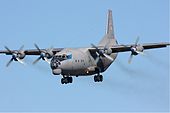
|
Tactical Transport | An-12 | 25[32] | ||
| Antonov An-72 | 
|
Tactical Transport | An-72 | 17[32] | ||
| Antonov An-24 Antonov An-26 |

|
Tactical Transport | An-24/An-26 | 70[32] | ||
| Ilyushin Il-62 | 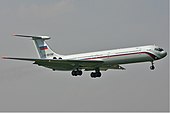
|
Airliner (passenger) | IL-62M | 5[32] | ||
| Tupolev Tu-154 | 
|
Airliner (passenger) | Tu-154M | 2[32] | ||
| Antonov An-148 | 
|
Airliner (passenger) | An-148-100E | 5 [51] | 15 on order. | |
| Let L-410 Turbolet | 
|
Utility Transport | L-410 | 50[32] | ||
| Yakovlev Yak-40 | 
|
VIP Transport | Yak-40 | 17[32] | ||
| Antonov An-140 | 
|
VIP Transport | An-140-100 | 4[32] | 6 more on order. | |
| Special-mission aircraft | ||||||
| Beriev A-50 | 
|
Airborne Early Warning & Control | A-50M A-50U |
28[32] | ||
| Ilyushin Il-78 | 
|
Aerial Refueling | IL-78 IL-78M |
23[32] | ||
| Ilyushin Il-20 | 
|
Radar reconnaissance | IL-20M | 20[52] | ||
| Mikoyan MiG-25 | 
|
Reconnaissance | MiG-25R | 42[32]
I All MiG-25 were retired from service. | ||
| Ilyushin Il-80 | 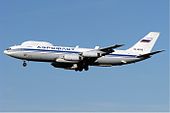
|
Command & Control | IL-80 | 4 | ||
| Beriev Be-200 | 
|
Amphibious Aircraft | Be-200PS Be-200ChS |
Ordered 12 Be-200ChS and 4 Be-200PS on 2016. Plans for an additional 8 underway.[53] The aircraft is designed to carry 12 tons of water. | ||
| Training aircraft | ||||||
| Yakovlev Yak-130 | 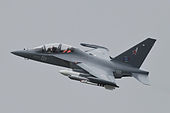
|
Training Aircraft | Yak-130 | 53[39] | ||
| Aero L-39 Albatros | 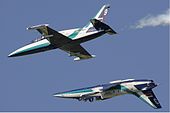
|
Training Aircraft | L-39 | 200[32] | To be replaced with the Yak-130. | |
| Tupolev Tu-134 | 
|
Training Aircraft | Tu-134UBL | 17[32] | ||
| Helicopters | ||||||
| Kamov Ka-50 | 
|
Attack Helicopter | Ka-50 | 8 | Cancelled in favor of the Ka-52. | |
| Kamov Ka-52 | 
|
Attack Helicopter | Ka-52 | 63[54] | At least 114 on order. | |
| Mil Mi-24 Mil Mi-35 |

|
Attack Helicopter | Mi-24V/P Mi-35М |
298/34[32] | 15 on order. | |
| Mil Mi-28 | 
|
Attack Helicopter | Mi-28N | 89 [32] | 8 on order. | |
| Mil Mi-8 Mil Mi-17 Mil Mi-171 |

|
Transport Helicopter | Mi-8MT Mi-8T Mi-8MTV-5 Mi-8AMTSh Mi-17(8M) Mi-17-1V Mi-17-1M Mi-171S Mi-171Sh |
363[55] | 281 to be delivered. | |
| Mil Mi-26 | 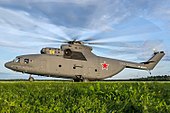
|
Transport Helicopter | Mi-26 Mi-26(T) |
41[32] | 9 on order. | |
| Kamov Ka-226 | 
|
Utility Helicopter | Ka-226 | 10[32] | ||
| Kazan Ansat | 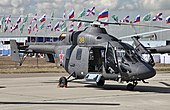
|
Training Helicopter | Ansat-U | 25[32] | 7 on order. | |
| Mil Mi-2 PZL Mi-2 |

|
Utility Helicopter | Mi-2 | 18[32] | ||
| Kamov Ka-28 | 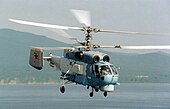
|
Utility Helicopter | Ka-28 | 1[32] | ||
| Kamov Ka-29 | 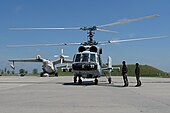
|
Utility Helicopter | Ka-29 | 21 | ||
| UAVs | ||||||
| Yakovlev Pchela | 
|
UAV | PCHELA-1T | Unknown | ||
| Tupolev-243 REIS-D | 
|
UAV | REIS-D | Unknown | ||
| IAI Searcher | 
|
UAV | Forpost | 2[56] | ||
Experimental aircraft
The following table includes relatively recent and notable experimental aircraft and technology demonstrators which have showcased many advanced technologies.
| Aircraft | Photo | Origin | Role | Version | Number | Comment |
|---|---|---|---|---|---|---|
| Sukhoi Su-47 | 
|
Fighter Aircraft | Su-47 | 4 | Experimental aircraft and technology demonstrator which showcased many advanced technologies now used in the Sukhoi PAK FA. | |
| Sukhoi Su-37 | 
|
Multirole Fighter | Su-37 | 2 | Experimental supermaneuverable multirole jet fighter demonstrator[57] | |
| Mikoyan MiG-33 | 
|
Multirole Fighter | MiG-29M MiG-29M2[58] |
6 | ||
| Beriev A-60 | 
|
Airborne laser laboratory/Anti-satellite weapon | 2 | Testing by program Sokol Eshelon |
Future of the Russian Air Force
Future aircraft
| Aircraft | Photo | Origin | Role | Version | Number | Comment |
|---|---|---|---|---|---|---|
| Sukhoi PAK FA | 
|
Fifth-generation jet fighter | Su-Pak Fa | 5 | Expected to enter service starting 2016.[59] | |
| Mikoyan MiG-35 | 
|
4++ generation jet fighter | MiG-35 | Started production in 2013. Initial orders for around 37 expected.[60] Around 100 to be built after 2016.[61] | ||
| Kamov Ka-60 | 
|
Utility Helicopter | Ka-60 | Starting serial production in 2014-15. Around 100 will be procured.[62][63] | ||
| Mil Mi-38 | 
|
Transport helicopter | Mi-38 | 3 | Starting serial production in 2014-15.[64] | |
| Mikoyan Skat | 
|
UCAV | Skat | The project is in development phase. | ||
| PAK DA | bomber | Pak Da | Stealth bomber expected to enter service in 2025 | |||
| Beriev A-100 | Airborne early warning and control | A-100 | Replaces A-50U | |||
| Il-112 | 
|
Tactical transport | Il-112 | Replaces An-26 | ||
| Il-214 | 
|
Tactical transport | Il-214 | Replaces An-12 and An-72 |
Aircraft deliveries by type 2009 onward
| Type | 2009 | 2010 | 2011 | 2012 | 2013 | |||
|---|---|---|---|---|---|---|---|---|
| Mi-28N | 13 | 11 | 12 | 15 | 14 | |||
| Mi-35M | 6 | 11 | 11 | |||||
| Ka-52 | 3 | 4 | 12 | 21 | 17 | |||
| Mi-8 family | 10 | 15 | 10 | 14 | 53 | |||
| Mi-26 | 4 | 7 | 3 | |||||
| Ka-226 | 1 | 9 | 9 | |||||
| Ansat-U | 6 | 8 | 5 | 6 | ||||
| Ka-31 | 2 | |||||||
| Total | 32 | 30 | 53 | 84 | 113 | |||
| Sources:[65][66][67][68] | ||||||||
| Type | 2009 | 2010 | 2011 | 2012 | 2013 |
|---|---|---|---|---|---|
| MiG-29SMT | 4 | ||||
| Su-27SM3 | 12 | ||||
| Su-30 family | 4 | 2 | 18 | ||
| Su-34 | 2 | 4 | 6 | 10 | 12 |
| Yak-130 | 1 | 4 | 8 | 15 | 18 |
| Su-35S | 2 | 8 | 12 | ||
| L-410UVP | 4 | 3 | |||
| An-140-100 | 1 | 2 | 3 | ||
| Tu-154M | 1 | 2 | |||
| Total | 7 | 13 | 31 | 42 | 63 |
| Sources:[69][70][71] | |||||
See also
- Awards and decorations of the Russian Federation
- Honorary titles of the Russian Federation
- List of Russian aviators
References
- ^ International Institute for Strategic Studies - IISS Military Balance 2010, p. 222
- ^ Austin & Muraviev, The Armed Forces of Russia in Asia, Tauris, 2000, p.235
- ^ Jeroen Brinkman, 'Russian Air Force in Turmoil,' Air Forces Monthly, No.105, December 1996, p.2, cited in Austin & Muraviev, 2000
- ^ General Heikki Nikunen, The Current State of the Russian Air Force, last updated 2005
- ^ Piotr Butowski, 'Russia's new air force enters a tight manoeuvre,' Jane's Intelligence Review, May 1999, p.14
- ^ Piotr Butowski, 'Russia Rising,' Air Forces Monthly, July 2007, p.83
- ^ Valeriy Kolosov, Military Reform: Minus One Hundred Thousand, Kommersant, 11 October 2004, cited in Scott & Scott, Russian Military Directory 2004
- ^ Routledge/IISS, IISS Military Balance 2007, p.200
- ^ a b Russia to build fifth-generation fighter prototype soon, 8 August 2007
- ^ a b RIA Novosti, Russia to equip two air regiments with Su-34 strike planes soon, 2 August 2007
- ^ "SU-34/32FN Fullback Long range fighter-bomber , Russian Arms, Military Technology, Analysis of Russia's Military Forces". Warfare.ru. Retrieved 1 June 2011.
- ^ "BBC NEWS, ',Russia restarts Cold War',, 17 August 2007, patrols". BBC News. 17 August 2007. Retrieved 1 June 2011.
- ^ Russia restores Soviet-era strategic bomber patrols – Putin −2 Russian News & Information Agency
- ^ "BBC NEWS, RAF intercepted Russian planes, 30 April 2008". BBC News. 30 April 2008. Retrieved 1 June 2011.
- ^ Warfare.ru, Air Force: structure accessed May 2009
- ^ "accessed August 2009". Combataircraft.net. Retrieved 1 June 2011.
- ^ "Russian Military Aircrew Numbers Tumble". Aviationweek.com. 16 December 2009. Retrieved 1 June 2011.
- ^ Reuters.com, One-third Russian fighter jets old and unsafe: report Friday, 6 February 2009 5:40 am EST
- ^ "Russian Military Weakness Increases Importance of Strategic Nuclear Forces". Cdi.org. 11 June 2009. Retrieved 1 June 2011.
- ^ "Russia upgrades bomber-ALCM force for 21st century". Upi.com. 5 January 2009. Retrieved 1 June 2011.
- ^ RIAN, Sukhoi signs record $2.5 bln deal with Russian defence ministry, August 2009
- ^ "18 September 2009". Asbarez.com. 10 February 1995. Retrieved 1 June 2011.
- ^ Reuben F Johnson, Russian consortium to develop PAK-FA engine, Jane's Defence Weekly, 19 April 2010
- ^ John Pike. "Russian fighter jets make first ever nonstop flight across Russia to Far East". Globalsecurity.org. Retrieved 1 June 2011.
- ^ "Радиостанция "Эхо Москвы" / Передачи / Военный совет / Суббота, 14.08.2010: Александр Зелин". Echo.msk.ru. Retrieved 1 June 2011.
- ^ Moscow Defense Brief #2, 2010 page 23
- ^ http://www.sdelanounas.ru/blogs/25568/
- ^ Dmitry Gorenburg, Air Force Structure, February 7, 2011
- ^ http://sdelanounas.ru/blogs/30685/
- ^ п═я┐я│п╩п╟п╫ п⌠п╦я─я└п╟п╫п╬п╡. "Aviation EXplorer: п░п╩п╣п╨я│п╟п╫п╢я─ п≈п╣п╩п╦п╫: п║-400 п╫п╟я┤п╫п╣я┌ п╥п╟я┴п╦я┴п╟я┌я▄ пЁя─п╟п╫п╦я├я▀ п═п╬я│я│п╦п╦ п╡ 2012 пЁп╬п╢я┐". Aex.ru. Retrieved 9 October 2012.
- ^ International Institute for Strategic Studies; Hackett, James (ed.) (7 March 2012). The Military Balance 2012. London: Routledge. ISBN 1857436423.
{{cite book}}:|author2=has generic name (help) p. 196 - ^ a b c d e f g h i j k l m n o p q r s t u v w x y z aa ab World Air Forces 2014 December 5, 2013 Flightglobal.com
- ^ a b c d "World Military Aircraft Inventory". 2014 Aerospace: Aviation Week and Space Technology, January 2014.
- ^ http://www.samara-airlines.ru/su-27-predlagayut-spisat/ Су-27 предлагают списать
- ^ http://lenta.ru/news/2011/11/03/su27sm/ Lenta.ru: Оружие: ВВС России получат восемь новых истребителей Су-27СМ
- ^ AirForces Monthly, Dec 2010
- ^ http://bmpd.livejournal.com/945390.html
- ^ http://bmpd.livejournal.com/1022382.html
- ^ a b http://bmpd.livejournal.com/976149.html
- ^ http://bmpd.livejournal.com/1057607.html
- ^ http://bmpd.livejournal.com/1074821.html
- ^ http://lenta.ru/news/2011/10/21/su24/
- ^ "нПСФХЕ: ббя пНЯЯХХ ЯОХЬСР АНЛАЮПДХПНБЫХЙХ яС-24 Й 2020 ЦНДС". Lenta.ru. Retrieved 9 October 2012.
- ^ Russia to Field New Ground Attack Jet 17-05-2012
- ^ http://bmpd.livejournal.com/1089442.html
- ^ "Ту-22М3 сделают убийцу ЕвроПРО Ради высокоточной ракеты бомбардировщику поменяют всю электронику - ВПК.name". Vpk.name. Retrieved 9 October 2012.
- ^ Jennings, Gareth (20 November 2014). "Russia flies first radar- and avionics-upgraded Tu-160 bomber". IHS Jane's 360. Retrieved 6 December 2014.
- ^ Raytheon
- ^ http://bmpd.livejournal.com/1056008.html
- ^ http://bmpd.livejournal.com/1093853.html
- ^ http://bmpd.livejournal.com/1030121.html
- ^ http://lenta.ru/news/2012/12/13/il20m/
- ^ MoD purchased six amphibious aircraft Be-200 May 27, 2013
- ^ http://bmpd.livejournal.com/700413.html
- ^ [1]
- ^ "Searcher II". Searcher II. Deagel.com. 3 December 2006. Retrieved 30 September 2014.
- ^ http://www.airwar.ru/enc/fighter/su37.html
- ^ http://www.airwar.ru/enc/fighter/mig29m.html
- ^ Russian Air Force pilot flies PAK-FA for first time 25 Apric 2013
- ^ RAC "MiG" in June to sign a contact with the Ministry of Defence for the supply of MiG-35 31-5-2013
- ^ http://en.ria.ru/military_news/20140415/189237858/Russian-Air-Force-to-Receive-16-New-MiG-Fighters.html
- ^ Kamov Ka-60, warfare.ru, Russian Military Analisis. Retrieved on September 8, 2008.
- ^ "World Air Forces 2013" (PDF). flightglobal.com. Retrieved 10 March 2013.
- ^ http://www.russianhelicopters.aero/ru/kvz/news/5437.html
- ^ http://bmpd.livejournal.com/491764.html
- ^ http://sdelanounas.ru/blogs/28241/
- ^ http://bmpd.livejournal.com/884607.html
- ^ http://bmpd.livejournal.com/723171.html
- ^ http://sdelanounas.ru/blogs/25527/
- ^ http://sdelanounas.ru/blogs/25482/
- ^ http://bmpd.livejournal.com/884298.html
101 http://sdelanounas.ru/blogs/44256/ 102http://sdelanounas.ru/blogs/43309/
Further reading
- Higham, Robin (editor). Russian Aviation and Air Power in the Twentieth Century. Routledge, 1998. ISBN 0-7146-4784-5
- Palmer, Scott W. Dictatorship of the Air: Aviation Culture and the Fate of Modern Russia. New York: Cambridge University Press, 2006. ISBN 0-521-85957-3
External links
- Russian Air Force Unofficial Template:Ru icon
- Kommersant-Vlast, State of Russia's Air Forces 2008 No.33 (786) 25 August 2008 Template:Ru icon
- VVS Order of Battle courtesy of Scramble.nl
- Russian-language VVS site[dead link]
- Photos Russian Air Force
- Russian Military Aviation
- "Russian Revival" - Russia´s technological strategy for post-2010 airpower

